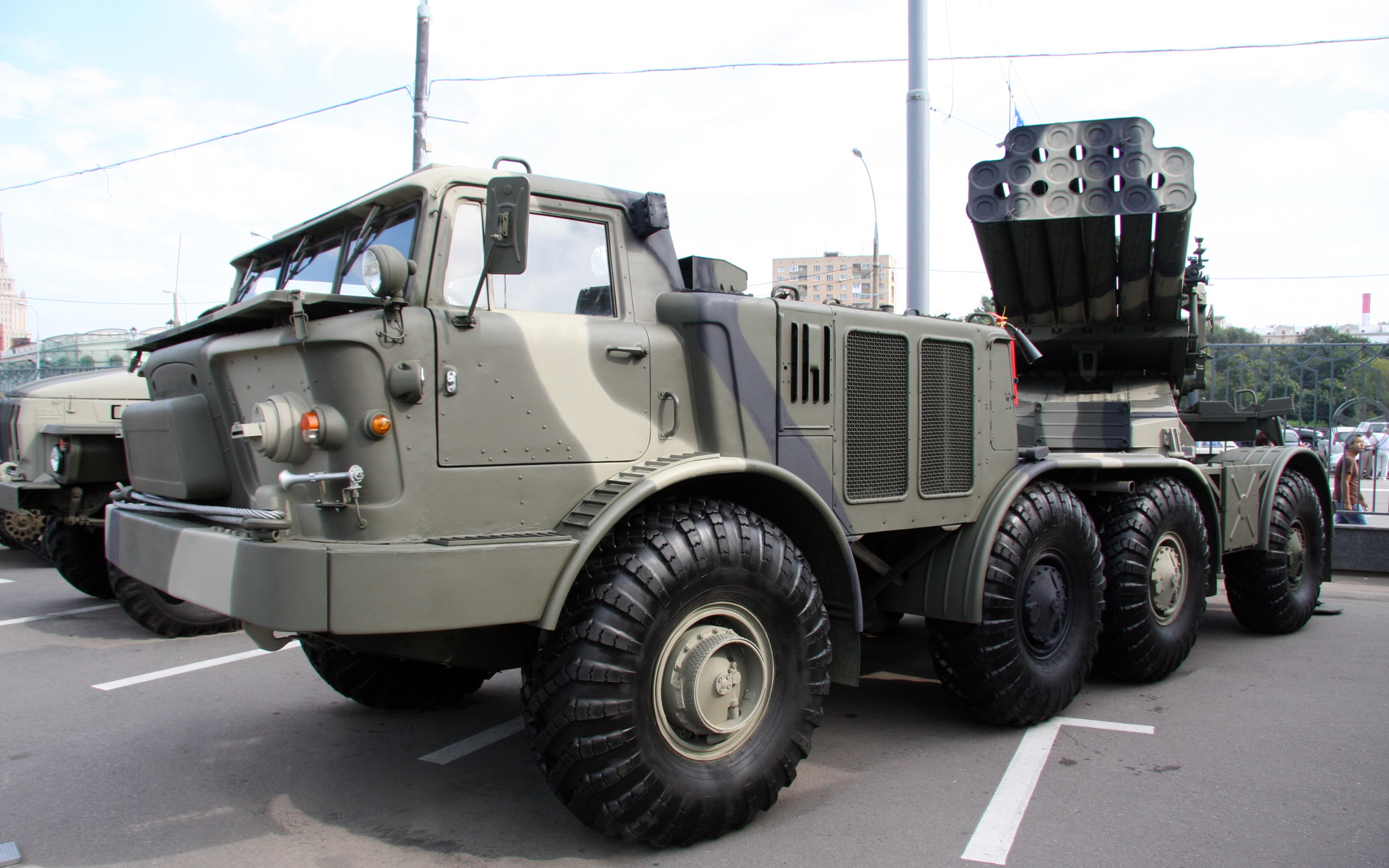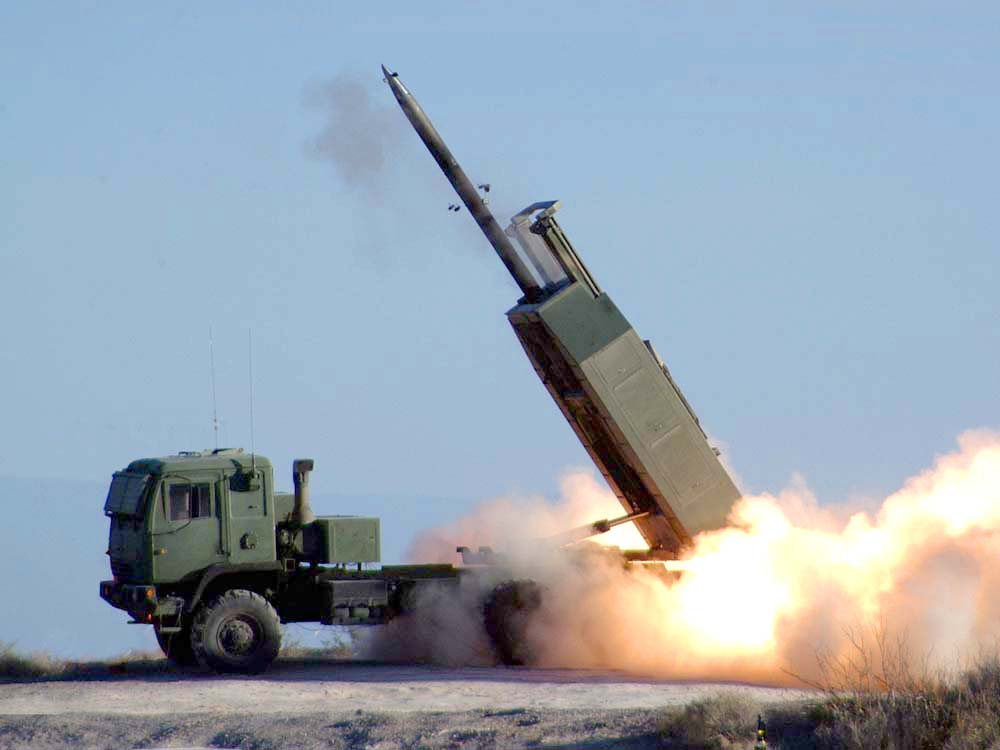|
BM-27
The BM-27 Uragan (; GRAU index 9P140) is a Self-propelled artillery, self-propelled 220 mm multiple rocket launcher designed in the Soviet Union to deliver cluster munitions. The system began its service with the Soviet Army in the late 1970s, and was its first spin and fin stabilized heavy multiple rocket launcher. An updated version known as 9К512 Uragan-1M, Uragan-1M was commissioned in 2008. The truck vehicle has no similarities. Description The BM-27 Uragan is capable of launching 220 mm rockets from 16 launch tubes mounted on the rear of a ZIL-135 8×8 chassis. This vehicle is extremely similar to that used in the FROG-7 free flight rocket system. It has two gasoline engines that power its 20 tonnes to a maximum speed of 65 kilometers per hour. One engine drives the four wheels on the left of the truck, while the other engine drives the four wheels on the right. The ZIL-135 has eight wheel drive, but only the front and rear axles are used for steering. It has a ... [...More Info...] [...Related Items...] OR: [Wikipedia] [Google] [Baidu] |
ZIL-135
The ZIL-135 is a large eight-wheeled military transport and Mobile launcher vehicle, self-propelled artillery truck manufactured by ZiL during the Cold War from the Soviet Union starting in 1959. Its purpose was to carry and launch a 9K52 Luna-M, Luna-M (NATO reporting name, NATO: Frog-7) surface-to-surface missile, surface-to-surface artillery rocket. The ZIL-135 was widely exported to other communist countries, most notably North Korea, where it is a common sight in films and military marches. It also served as the TEL for the BM-27 Uragan artillery rocket system. This vehicle has two gasoline engines that power its 20 tonnes to a maximum speed of . One engine drives the four wheels on the left of the truck, while the other engine drives the four wheels on the right. The ZIL-135 has eight wheel drive, but only the front and rear axles are used for steering. It has a maximum cruising range of . The cab of the ZIL-135 is NBC (weapon), NBC protected, allowing the rockets to be fi ... [...More Info...] [...Related Items...] OR: [Wikipedia] [Google] [Baidu] |
War In Abkhazia (1992–1993)
The War in Abkhazia was fought between Georgian government and paramilitary forces, and a coalition of Abkhaz separatist forces and North Caucasian militants between 1992 and 1993. Ethnic Georgians who lived in Abkhazia fought largely on the side of Georgian government forces. Ethnic Armenians, who formed the Bagramyan Battalion and Russians within Abkhazia's population largely supported the AbkhaziansAbkhazia Today. ''The Europe Report N°176, 15 September 2006, page 5''. Retrieved on 30 May 2007. ''Free registration needed to view full report'' and many fought on their side. The separatists received support from thousands of |
GRAU Index
The Main Missile and Artillery Directorate of the Ministry of Defense of the Russian Federation (), commonly referred to by its transliterated acronym GRAU (), is a department of the Russian Ministry of Defense. It is subordinate to the Chief of Armament and Munition of the Russian Armed Forces, a vice-minister of defense. The organization dates back to 1862 when it was established under the name Main Artillery Directorate (, GAU). The "R" from "rockets" was added to the title from 19 November 1960. The GRAU is responsible for assigning GRAU indices to Russian army ammunitions and equipment. As of April 2025, the Chief of the GRAU was Major General Aleksey Volkov. Arsenals Arsenals of the GRAU, according to Kommersant-Vlast in 2005, included the 53rd at Dzerzhinsk, Nizhniy Novogorod Oblast, the 55th in the Sklad-40 microraion at Rzhev, the 60th at Kaluga, the 63rd at Lipetsk, the 75th at Serpukhov south of Moscow, and the 97th at Skolin (all five in the Moscow Military Di ... [...More Info...] [...Related Items...] OR: [Wikipedia] [Google] [Baidu] |
Cluster Munitions
A cluster munition is a form of air-dropped or ground-launched explosive weapon that releases or ejects smaller submunitions. Commonly, this is a cluster bomb that ejects explosive bomblets that are designed to kill personnel and destroy vehicles. Other cluster munitions are designed to destroy runways or electric power transmission lines. Because cluster bombs release many small bomblets over a wide area, they pose risks to civilians both during attacks and afterwards. Unexploded ordnance, Unexploded bomblets can kill or maim civilians and unintended targets long after a conflict has ended, and are costly to locate and remove. This failure rate ranges from 2 percent to over 40 percent. Cluster munitions are prohibited for those nations that ratified the Convention on Cluster Munitions, adopted in Dublin, Ireland, in May 2008. The Convention entered into force and became binding international law upon ratifying states on 1 August 2010, six months after being ratified by 30 st ... [...More Info...] [...Related Items...] OR: [Wikipedia] [Google] [Baidu] |
Multiple Rocket Launcher
A multiple rocket launcher (MRL) or multiple launch rocket system (MLRS) is a type of rocket artillery system that contains multiple rocket launcher, launchers which are fixed to a single weapons platform, platform, and shoots its rocket (weapon), rocket ordnance in a fashion similar to a volley gun. Rockets are self-propelled in flight and have different capabilities than conventional artillery shell (projectile), shells, such as longer effective range, lower recoil, typically considerably higher payload than a similarly sized gun artillery platform, or even carrying multiple warheads. Unguided rocket artillery is notoriously inaccurate and slow to reload compared to gun artillery. A multiple rocket launcher helps compensate for this with its ability to launch multiple rockets in rapid succession, which, coupled with the large blast radius, kill zone of each warhead, can easily deliver saturation fire over a target area. However, modern rockets can use GPS or inertial guidance t ... [...More Info...] [...Related Items...] OR: [Wikipedia] [Google] [Baidu] |
NPO Splav
NPO Splav () is one of the leading global developers and manufacturers of multiple rocket launcher systems (MLRS), and one of the key companies providing Russian arms for the global market in the segment. It is the only company in Russia which designs and develops multiple launch rocket systems (MLRS) and cartridges. The company is part of the Techmash holding (Rostec). History NPO Splav was established in 1945. During the Russo-Ukrainian War on December 22, 2015, the United States through EO 13662 explicitly lists NPO Splav on the US Department of Treasury's Office of Foreign Assets Control (OFAC) Sectoral Sanctions Identifications List (SSI) because of its links to Rostec and blocks any United States person or entity or person in the United States from conducting business with NPO Splav and other entities associated with Rostec. In 2016, Splav joined with Motovilikha Plants. In early 2024, the company reported that it had increased the production of ammunition by 4 times. ... [...More Info...] [...Related Items...] OR: [Wikipedia] [Google] [Baidu] |
Soviet Army
The Soviet Ground Forces () was the land warfare service branch of the Soviet Armed Forces from 1946 to 1992. It was preceded by the Red Army. After the Soviet Union ceased to exist in December 1991, the Ground Forces remained under the command of the Commonwealth of Independent States until it was formally abolished on 14 February 1992. The Soviet Ground Forces were principally succeeded by the Russian Ground Forces in Russian territory. Outside of Russia, many units and formations were taken over by the post-Soviet states; some were withdrawn to Russia, and some dissolved amid conflict, notably in the Caucasus. While the Ground Forces are commonly referred to in English language sources as the Soviet Army, in Soviet military parlance the term '' armiya'' (army) referred to the combined land and air components of the Soviet Armed Forces, encompassing the Ground Forces as well as the Strategic Rocket Forces, the Air Defence Forces, and the Air Forces. After World W ... [...More Info...] [...Related Items...] OR: [Wikipedia] [Google] [Baidu] |
Second Nagorno-Karabakh War
The Second Nagorno-Karabakh War was an armed conflict in 2020 that took place in the disputed region of Nagorno-Karabakh and the Armenian-occupied territories surrounding Nagorno-Karabakh, surrounding occupied territories. It was a major escalation of an unresolved Nagorno-Karabakh conflict, conflict over the region, involving Azerbaijan, Armenia and the Political status of Nagorno-Karabakh, self-declared Armenian breakaway state of Republic of Artsakh, Artsakh. The war lasted for 44 days and resulted in Azerbaijani victory, with the defeat igniting 2020–2021 Armenian protests, anti-government protests in Armenia. Post-war skirmishes continued in the region, including substantial clashes in 2022. Fighting began on the morning of 27 September, with an Azerbaijani offensive along the Line of Contact (Nagorno-Karabakh), line of contact established in the aftermath of the First Nagorno-Karabakh War (1988–1994). Clashes were particularly intense in the less mountainous district ... [...More Info...] [...Related Items...] OR: [Wikipedia] [Google] [Baidu] |
9К512 Uragan-1M
The 9K512 "Uragan-1M" is a Russian multicaliber (220 mm/300 mm) multiple rocket launcher with the ability to swap launch containers, allowing it to use the same missiles as the BM-30 Smerch and Tornado (multiple rocket launcher). It is a modernized version of the BM-27 Uragan. History In the mid-1990s, Russia began developing a new 9K512 Uragan-1M bi-caliber rocket system. In 1995, the Bryansk Automobile Plant started designing a chassis based on the BAZ-6910 "Voshchina-1" for the new MLRS. However, due to a lack of funding, all work on its design was stopped at the end of 1996. Simultaneously, the designers at Motovilikha Plants explored the option of basing the system on the MZKT-7930 "Astrolog" chassis. After reviewing the projects, the Ministry of Defense chose the option of placing wheeled tractors on a chassis produced by the Minsk Plant. In this form, the new Uragan-1M MLRS entered testing. In 2012, tests were conducted on the system. According to the state armament p ... [...More Info...] [...Related Items...] OR: [Wikipedia] [Google] [Baidu] |
Multiple Rocket Launcher
A multiple rocket launcher (MRL) or multiple launch rocket system (MLRS) is a type of rocket artillery system that contains multiple rocket launcher, launchers which are fixed to a single weapons platform, platform, and shoots its rocket (weapon), rocket ordnance in a fashion similar to a volley gun. Rockets are self-propelled in flight and have different capabilities than conventional artillery shell (projectile), shells, such as longer effective range, lower recoil, typically considerably higher payload than a similarly sized gun artillery platform, or even carrying multiple warheads. Unguided rocket artillery is notoriously inaccurate and slow to reload compared to gun artillery. A multiple rocket launcher helps compensate for this with its ability to launch multiple rockets in rapid succession, which, coupled with the large blast radius, kill zone of each warhead, can easily deliver saturation fire over a target area. However, modern rockets can use GPS or inertial guidance t ... [...More Info...] [...Related Items...] OR: [Wikipedia] [Google] [Baidu] |
Rocket
A rocket (from , and so named for its shape) is a vehicle that uses jet propulsion to accelerate without using any surrounding air. A rocket engine produces thrust by reaction to exhaust expelled at high speed. Rocket engines work entirely from propellant carried within the vehicle; therefore a rocket can fly in the vacuum of space. Rockets work more efficiently in a vacuum and incur a loss of thrust due to the opposing pressure of the atmosphere. Multistage rockets are capable of attaining escape velocity from Earth and therefore can achieve unlimited maximum altitude. Compared with airbreathing engines, rockets are lightweight and powerful and capable of generating large accelerations. To control their flight, rockets rely on momentum, airfoils, auxiliary reaction engines, gimballed thrust, momentum wheels, deflection of the exhaust stream, propellant flow, spin, or gravity. Rockets for military and recreational uses date back to at least 13th-century China. ... [...More Info...] [...Related Items...] OR: [Wikipedia] [Google] [Baidu] |








